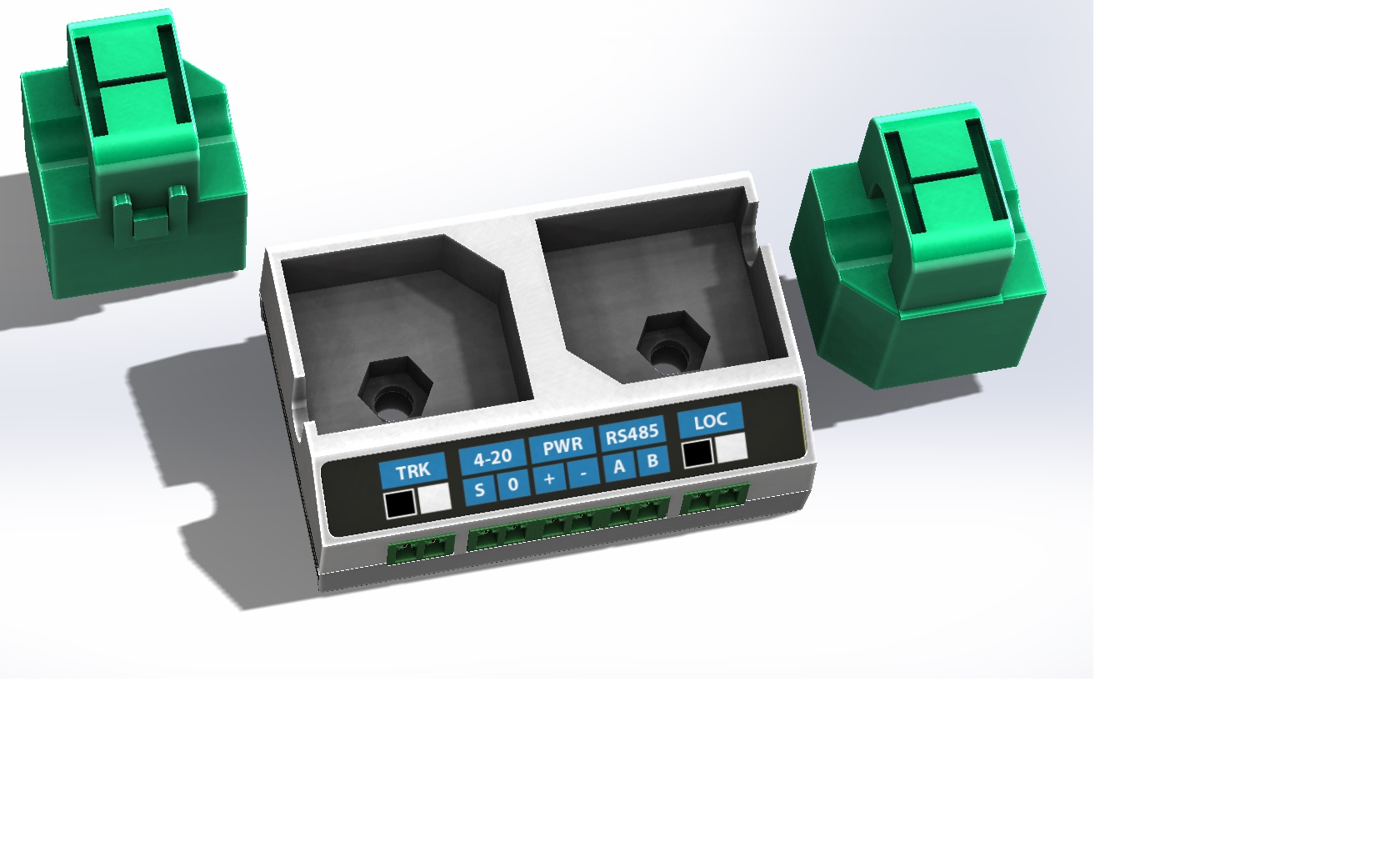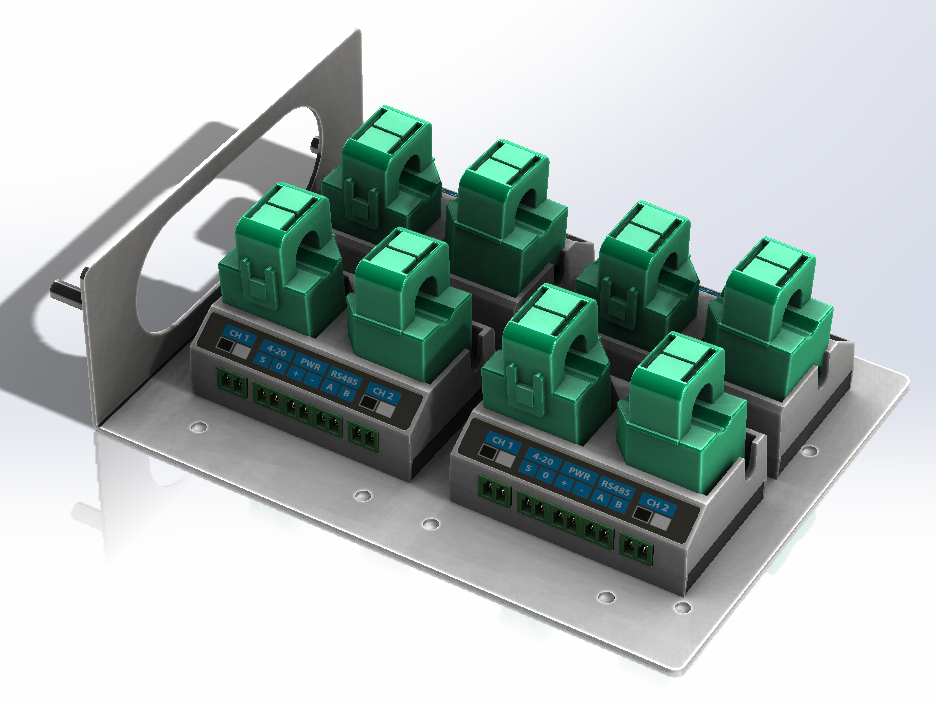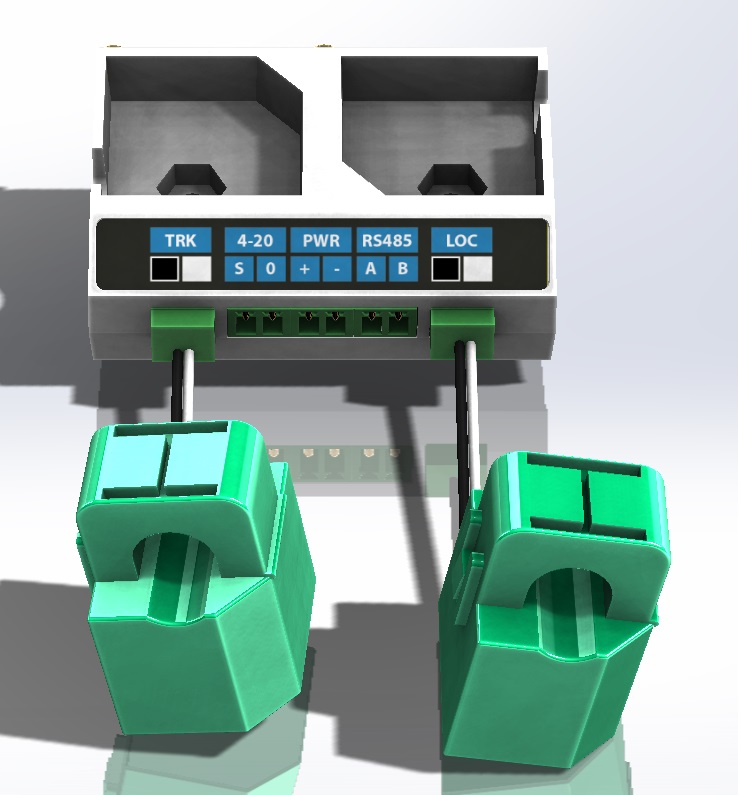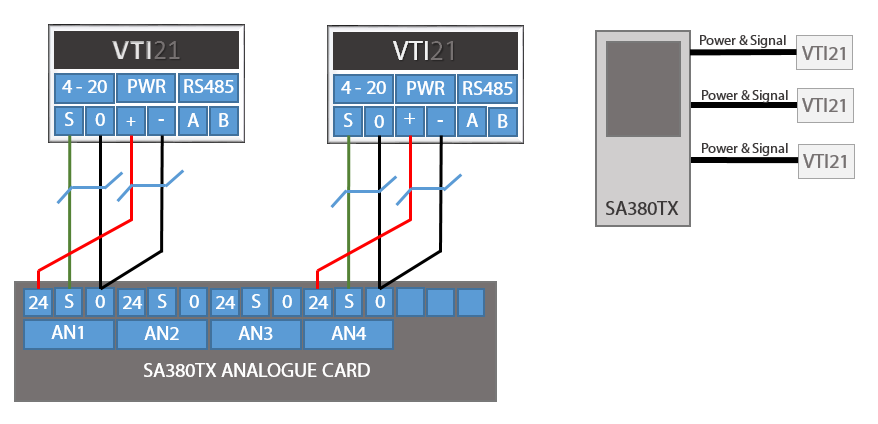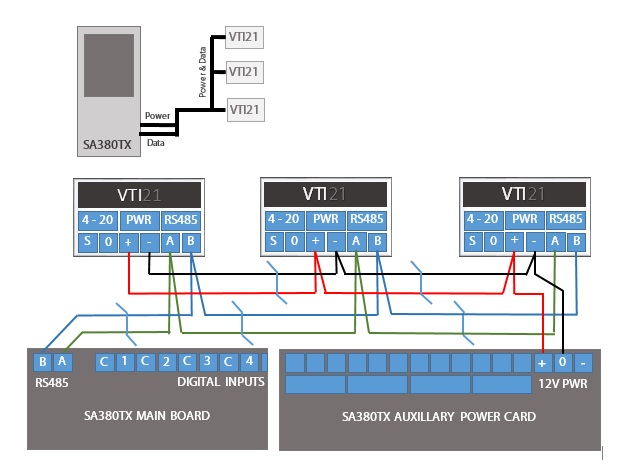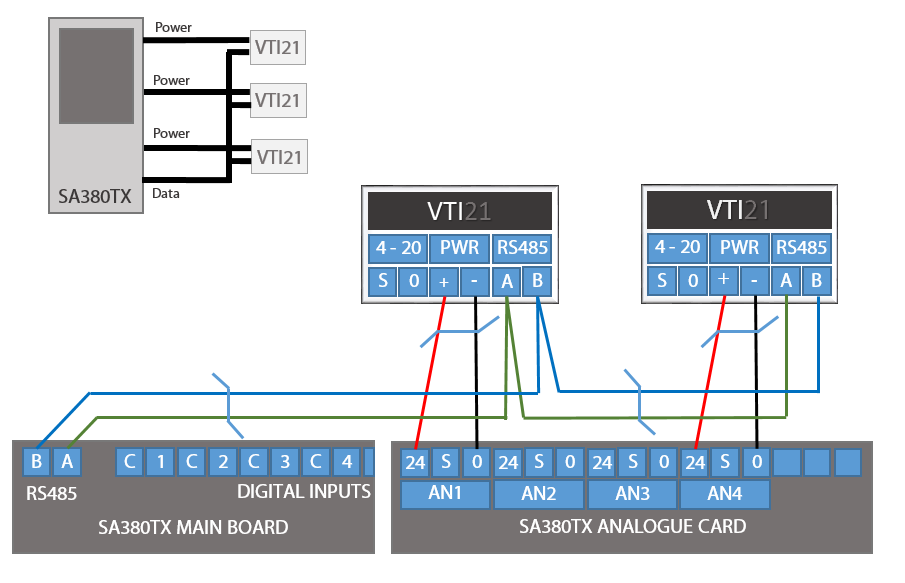VTi21 Hardware
Introduction
The VTi21 has been designed for the monitoring of railway assets that require high-speed sampling and/or multiple input channels.
It has been designed with a small form factor to allow for simple installation, and ships with two "current transformer" sensors suitable for alternating-current monitoring. Such technology is suitable for many track circuit and switch machine technologies.
The VTi21 contains an on-board microprocessor that processes the raw incoming waveforms, and derives computed values that are relevant from a condition based maintenance perspective.
The VTi21 can derive many output parameters from the source data, and all of these parameters can be output over the RS485 data link to a connected Mpec data logger.
A single value, selected based upon it's value from a condition based maintenance perspective, is output on the 4-20mA output. This can be fed into any industry standard 4-20mA data logger input.
The primary railway assets for which the VTi21 unit has been designed are:
- AC vane relay (VT1 / 85Hz / 60Hz Vane Relay)
- Audio frequency (TI21 / FS2500 / FS2600 / Aster / UM71 / Reed)
- High voltage impulse (HVI)
- Single-Phase AC Switch Machines
- Three-Phase AC Switch Machines
- General Purpose AC sensing
- Reed Frequency-division-multiplexing Systems
Each application requires custom firmware to be run on the VTi21 hardware. Therefore each VTi21 board can only be used to monitor a limited type of assets. The firmware version is indicated on the base of the unit and can be specified upon ordering.
Later VTi21 devices purchased after September 2019 are programmable in the field, allowing the VTi21 to be re-purposed. Contact Mpec for further details.
Application | Product Code |
|---|---|
| AC Vane Relay (VT1) Applications | VTi21-VT1 |
| Audio Frequency (EbiTrack 200 / TI21) Applications (Transmitter) | VTi21-TI21-TX |
| Audio Frequency (EbiTrack 200 / TI21) Applications (Transmitter - Low Power) | VTi21-TI21-TX-LP |
| Audio Frequency (EbiTrack 200 / TI21) Applications (Receiver) | VTi21-TI21-RX |
| Audio Frequency (FS2500) Track Circuit Applications | VTi21-FS25 |
| Audio Frequency (FS2600) Track Circuit Applications | VTi21-FS26 |
| Aster Applications | VTi21-ASTER |
| UM71 Applications | VTi21-UM71 |
| Reed Applications | VTi21-REED |
| High Voltage Impulse (HVI) Applications | VTi21-HVI |
| General Purpose AC Sensing Applications | VTi21-ACS |
| Reed Frequency Division Multiplexing | VTi21-RFDM |
| BR930 / QStyle Bracket for mounting 4 x VTi21 | BRK-GEN |
- Please quote the above product codes when ordering.
- Firmware version of existing units can be determined by examining the label on the underside of the device.
The main hardware features are:
- Twin voltage sensing inputs (+/-1.25V)
- High-speed sample rate (50 kHz)
- Principal measurement via 4-20 mA output
- Multi-channel RS485 output
- Power supply: 12V to 24V DC
The VTi21 ships with two "current transformer" sensors:
- Split core design
- Galvanic isolation
- Integrates with VTi21 enclosure
- Sensitivity: VTi21-ACS and VTi21-HVI - 15 Amps per Volt
- Sensitivity: VTi21-UM71 (Rx) and VTi21-ASTER - 90 mA per Volt
- Sensitivity: All other variants - 3 Amps per Volt
- Frequency Response: 5Hz to >25kHz
Electrical Isolation Policy
The VTi21 does not feature any isolating components.
Isolation is achieved by:
- Galvanic isolation of the current transformer
- Galvanic isolation of the Incoming power supply
- Galvanic isolation of the 4-20mA input on the logging device
- Galvanic isolation of the RS485 port on the logging device
- Galvanic isolation from Earth
All Mpec data logging equipment has isolation at all of the above interfaces in excess of 1 MΩ at 1 kV.
Risk of the CT inducing current in the primary (measured) conductor:
The current transformer has a primary to secondary winding ratio of around 1:1000.
It would therefore take around 500 volts to be applied to the secondary winding, at the correct frequency and phase, in order to falsely energise a track circuit.
In the incredibly unlikely event that the above did occur, the secondary winding of the transducer, and the magnetic material forming the CT core, could not sustain such a signal.
In practice the magnetic core would reach flux saturation prior to supporting enough energy to induce significant primary current.
A signal of the order of 500V would also heat the secondary winding to a point where it would melt and short out.
Installation
Mounting Options
The current transformers can be removed from the VTi21 sensor body by releasing the grub screws at the rear of the unit.
This exposes two mounting holes.
These mounting centers have been designed to accept:
- M5 Hex Bolts
- No. 8 (4mm) Pan Head Screws
Bolts and screws are supplied with each VTi21 unit.
This allows a wide array of mounting options.
- Wooden Backboard
- Sheet Metal
- Slotted DIN Rail
- Drilled Relay Bar
- Trunking Cover
Mpec are able to manufacture mounting brackets to suit customer specific mounting arrangements:
- BR930 / Q Style mounting bracket
- VT1 Plug board bracket
The VTi21 mounting bracket is made from A2 stainless steel, and occupies one relay position. Each bracket can accommodate up to 4 x VTi21 devices.
Please contact Mpec to discuss mounting bracket requirements.
Transducer Placement
The supplied current transducers can be "docked" into the VTi21 body for compact installation.
This allows the tail cables of the current transformers to be shortened.
Alternatively, the transducers are small and light enough to be hung directly from monitored conductors, or secreted in cable trunking.
In this instance, excess transducer tail cable can still be shortened to suit.
Wiring Arrangement
Connection of Current Transducers
Connect one current transducer to the left hand CT input (product marking will vary dependent on application).
Connect the second current transducer to right hand CT input (product marking will vary dependent on application).
The VTi21 label is colour coded to ensure that the correct cable cores are connected to the correct input.
Please note the the transducers will function regardless of the polarity of connection, however for phase sensitive applications such as VT1 monitoring, incorrect readings will be obtained if correct wiring is not observed.
Take care when connecting power supply (PWR) to the VTi21!
- Reverse polarity connection will destroy the VTi21
- Connecting 24V to Input channels will destroy the VTi21
- Ensure power supply is isolated from the signalling supply
- Ensure power supply has over-current protection or is short circuit tolerant
Wiring for 4-20mA Operation
The VTi21 4-20mA output can be used to transmit a single application dependent parameter to any data logger that that accept 4-20mA instrumentation signals.
Wiring for an Mpec SA380TX is shown above for convenience. Twisted pairs are preferred, however for short cable runs, it is not essential.
The 4-20mA current loop signal will flow from the "4-20" pins.
- From "S" pin on VTi21 board into the logging device.
- Best results are achieved if the current is allowed to return to the sensor through the "0" pin.
Most data loggers, the SA380TX included, provide a power supply for powering off-board sensors. The VT21 is to be powered via the "+" and "-" pins.
- + must be connected to +12V to +24V DC.
- - must be connected to 0V DC.
- The VTi21 consumes 1.1W at 24VDC in 4-20mA mode.
The above wiring can be realised using a single 4-core cable per VTi21.
NEVER wire 4-20mA output to relay coils or other signalling device inputs.
In the presence of strong radiated Electromagnetic fields (>3 V/m in the region of 1.8 to 2.0 GHz ) the 4-20mA output may experience a drop in accuracy from +/-1% to +/- 2.5%. If undesirable interference is observed then use screened cable for the 4-20 mA interface. The cable screen should be terminated to earth at one end.
Wiring for RS485 Operation
The VTi21 RS485 output can be used to transmit the multiple application dependent parameters on the RS485 bus to Mpec SA380TX data loggers.
Up to 7 x VTi21 sensors can be supported with a single RS485 input and an auxiliary power supply card.
The power and data bus cables can be up to 1,500m in length.
Although at first glance the below wiring arrangement may look complex, in practice it means that a single 4-core cable can be "daisy chained" between logger and all connected VTi21 boards, resulting in quicker and tidier installations.
The RS485 data link uses a bus topology. A single twisted pair is to be "daisy chained" between logger and VTi21 sensors as shown
- Ensure "A" connectors are common between logger and all VTi21 devices
- Ensure "B" connectors are common between logger and all VTi21 devices
Power connection can also be daisy chained between VTi21 sensors.
- The SA380TX can be configured with an auxiliary power supply card.
- This supply will deliver a +/-12V dual rail voltage at 4W per rail.
- 12V DC at 4W is therefore available between "+" and "0" pins.
- 12V DC at 4W is also available between "0" and "-" pins (12V on pin "0" relative to 0V on pin "-").
The power consumption of the VT21 at 12V DC is 0.5W maximum, therefore:
- Up to 8 VTi21 boards can be powered from the "+" and "0" power connections. A single SA380TX currently only supports 7 VTi21 boards.
- NEVER wire RS485 cables into data inputs of computer based interlockings
- Although the VTi21 features surge protected inputs, consider using additional lightning arrestor devices for "Power" and "RS485" data cables over 30m in length
Alternate Wiring for RS485 Operation
Where an SA380TX does not have an auxiliary power supply card fitted but does have analogue input cards fitted; VTi21 sensors can still be used in RS485 mode by wiring as follows.
This wiring scheme is not optimal, as power cable needs to be run individually for each VTi21 sensor.
The RS485 data link uses a bus topology. A single twisted pair is to be "daisy chained" between logger and VTi21 sensors as shown
- Ensure "A" connectors are common between logger and all VTi21 devices
- Ensure "B" connectors are common between logger and all VTi21 devices
Power is provided by the SA380TX analogue input channels, these inputs provide a power supply for powering off-board sensors.
- + must be connected to "24"
- - must be connected to "0".
- The VTi21 consumes 0.8W at 24VDC in RS485 mode. In theory, 2 x VTi21 sensors may be connected to each analogue input power supply.

